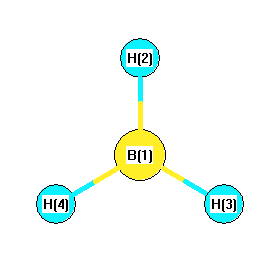Geometric Data

Point Group
Internal coordinates
distances (r) in Å, angles (a) in degrees, dihedrals (d) in degrees
| Description |
Value |
unc. |
Connectivity |
Reference |
Comment |
| Atom 1 |
Atom 2 |
Atom 3 |
Atom 4 |
| rBH |
1.190 |
|
1 |
2 |
|
|
1998Kuc |
r0 value |
Cartesians
| Atom |
x (Å) |
y (Å) |
z (Å) |
| B1 |
0.0000 |
0.0000 |
0.0000 |
| H2 |
0.0000 |
1.1900 |
0.0000 |
| H3 |
1.0306 |
-0.5950 |
0.0000 |
| H4 |
-1.0306 |
-0.5950 |
0.0000 |
Atom - Atom Distances 
Distances in Å
| |
B1 |
H2 |
H3 |
H4 |
| B1 |
|
1.1900 | 1.1900 | 1.1900 |
| H2 |
1.1900 |
|
2.0612 | 2.0612 |
| H3 |
1.1900 | 2.0612 |
|
2.0612 |
| H4 |
1.1900 | 2.0612 | 2.0612 |
|
Calculated geometries
for BH
3+ (boron trihydride cation).
Experimental Bond Angles (degrees) from cartesians 
| atom1 |
atom2 |
atom3 |
angle |
|
atom1 |
atom2 |
atom3 |
angle |
| H2 |
B1 |
H3 |
120.000 |
|
H2 |
B1 |
H4 |
120.000 |
| H3 |
B1 |
H4 |
120.000 |
Bond descriptions
Examples: C-C single bond, C=C, double bond, C#C triple bond, C:C aromatic bond
Connectivity
| Atom 1 |
Atom 2 |
| B1 |
H2 |
| B1 |
H3 |
| B1 |
H4 |
Dipole, Quadrupole and Polarizability
Electric dipole moment 
| State |
Config |
State description |
Conf description |
Exp. min. |
Dipole (Debye) |
Reference |
comment |
Point Group |
Components |
| x |
y |
z |
total |
dipole |
quadrupole |
| 1 |
1 |
1A1' |
D3h |
False |
|
|
|
0.000 |
NSRDS-NBS10 |
|
D3h |
0 |
1 |
| 1 |
3 |
1A1 |
C2v |
False |
|
|
|
|
|
|
C2v |
1 |
2 |
Experimental dipole measurement abbreviations: MW microwave; DT Dielectric with Temperature variation; DR Indirect (usually an upper limit); MB Molecular beam
Calculated electric dipole moments for
BH
3+ (boron trihydride cation).
Electric quadrupole moment 
| State |
Config |
State description |
Conf description |
Exp. min. |
Quadrupole (D Å) |
Reference |
comment |
Point Group |
Components |
| xx |
yy |
zz |
dipole |
quadrupole |
| 1 |
1 |
1A1' |
D3h |
False |
|
|
|
|
|
D3h |
0 |
1 |
| 1 |
3 |
1A1 |
C2v |
False |
|
|
|
|
|
C2v |
1 |
2 |
Calculated electric quadrupole moments for
BH
3+ (boron trihydride cation).











